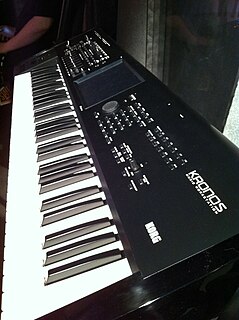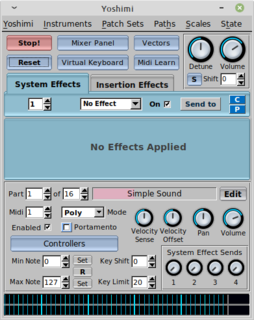
MIDI is a technical standard that describes a communications protocol, digital interface, and electrical connectors that connect a wide variety of electronic musical instruments, computers, and related audio devices for playing, editing and recording music. The specification originates in a paper titled Universal Synthesizer Interface, published by Dave Smith and Chet Wood, then of Sequential Circuits, at the October 1981 Audio Engineering Society conference in New York City.
A software synthesizer, also known as a softsynth or software instrument, is a computer program or plug-in that generates digital audio, usually for music. Computer software that can create sounds or music is not new, but advances in processing speed now allow softsynths to accomplish the same tasks that previously required the dedicated hardware of a conventional synthesizer. Softsynths may be readily interfaced with other music software such as music sequencers typically in the context of a digital audio workstation. Softsynths are usually less expensive and can be more portable than dedicated hardware.
Modular synthesizers are synthesizers composed of separate modules of different functions. The modules can be connected together with patch cords, a matrix patching system, or switches by the user to create a patch. The output (voltages) from the modules may function as (audio) signals, control voltages, or logic/timing conditions. Typical modules are oscillators, filters (spectrum), amplifiers/gates (amplitude) and Envelope generators.
A music workstation is an electronic musical instrument providing the facilities of:

Virtual Studio Technology (VST) is an audio plug-in software interface that integrates software synthesizers and effects units into digital audio workstations. VST and similar technologies use digital signal processing to simulate traditional recording studio hardware in software. Thousands of plugins exist, both commercial and freeware, and many audio applications support VST under license from its creator, Steinberg.

GarageBand is a line of digital audio workstations for macOS, iPadOS, and iOS devices that allows users to create music or podcasts. GarageBand is developed and sold by Apple for macOS, and is part of the iLife software suite, along with iMovie. Its music and podcast creation system enables users to create multiple tracks with pre-made MIDI keyboards, pre-made loops, an array of various instrumental effects, and voice recordings.

A digital audio workstation (DAW) is an electronic device or application software used for recording, editing and producing audio files. DAWs come in a wide variety of configurations from a single software program on a laptop, to an integrated stand-alone unit, all the way to a highly complex configuration of numerous components controlled by a central computer. Regardless of configuration, modern DAWs have a central interface that allows the user to alter and mix multiple recordings and tracks into a final produced piece.

The Roland JX-3P is a synthesizer produced by Roland Corporation of Japan from 1983-1985. The "3P" in its name refers to "Programmable Preset Polyphonic". It is notable as one of the company's first synthesizers to incorporate a MIDI interface.
DirectMusic is a deprecated component of the Microsoft DirectX API that allows music and sound effects to be composed and played and provides flexible interactive control over the way they are played. Architecturally, DirectMusic is a high-level set of objects, built on top of DirectSound, that allow the programmer to play sound and music without needing to get quite as low-level as DirectSound. DirectSound allows for the capture and playback of digital sound samples, whereas DirectMusic works with message-based musical data. Music can be synthesized either in hardware, in the Microsoft GS Wavetable SW Synth, or in a custom synthesizer.
Reaktor is a graphical modular software music studio developed by Native Instruments (NI). It allows musicians and sound specialists design and build their own instruments, samplers, effects and sound design tools. It is supplied with many ready-to-use instruments and effects, from emulations of classic synthesizers to futuristic sound design tools. In addition, more than 3000 free instruments can be downloaded from the growing User Library. One of Reaktor's unique selling points is that all of its instruments can be freely examined, customized or taken apart; Reaktor is a tool that effectively encourages reverse engineering. Reaktor Player is a free limited version of the software that allows musicians to play NI-released Reaktor instruments, but not edit or reverse-engineer them.
The Ensoniq Fizmo was Ensoniq's last attempt at creating the perfect synthesizer. Developed in 1998, the Fizmo uses a Digital Acoustic simulation Transwave with 4 MB of ROM, up to four voices per preset, each voice with two oscillators, independent LFOs and FX: 48 voices maximum, with three separate fx units built in for further sound sculpting. The Fizmo featured 61 keys, and responded to velocity, channel aftertouch, as well as allowing the sounds to be split by velocity and keyboard position (note). The name F-I-Z-M-O was mapped across five control knobs just above the keyboard keys, allowing real-time modulation of the waves for more user controlled evolving sounds than a usual synthesizer could provide, as well as also having 17 dedicated Sound and Effect editing knobs for further sound design and editing.

The Korg Polysix(PS-6) is a six-voice programmable polyphonic analog synthesizer released by Korg in 1981.

The Korg Wavestation is a vector synthesis synthesizer first produced in the early 1990s and later re-released as a software synthesizer in 2004. Its primary innovation was Wave Sequencing, a method of multi-timbral sound generation in which different PCM waveform data are played successively, resulting in continuously evolving sounds. The Wavestation's "Advanced Vector Synthesis" sound architecture resembled early vector synths such as the Sequential Circuits Prophet VS.

LMMS is a digital audio workstation application program. When LMMS is executed on a computer with appropriate hardware, it allows music to be produced by arranging samples, synthesizing sounds, playing on a MIDI keyboard, and combining the features of trackers and sequencers. It supports the Linux Audio Developer's Simple Plugin API (LADSPA), LV2 and Virtual Studio Technology (VST) plug-ins. It is free software, written in Qt and released under the GNU General Public License, version 2 (GPLv2).

Roland JX-8P is a 61-key, velocity- and aftertouch-sensitive, six-note polyphonic, fully analog synthesizer released by Roland in 1985. In a time of rising popularity of digital frequency modulation synthesizers, such as Yamaha DX7, JX-8P was marketed as the best of both worlds: while it was possible to create classic analog synth sounds, several new modulation parameters and redesigned hardware enabled it to produce certain types of sounds associated with FM synthesis, such as metallic percussive sounds. Likewise, traditional hands-on controls were replaced with a DX-style interface with membrane buttons and one "edit" slider.

The Roland AX-Synth is a keytar that is manufactured by Roland Corporation, and was released in late August 2009. This modernized instrument builds on the features of its predecessor, the Roland AX-7. The most notable change is the addition of an internal synthesizer. A UV Black-colored "premium" model called "Black Sparkle" was released in September 2010. The AX-Synth has now been discontinued as well.

Cantor was a vocal singing synthesizer software released four months after the original release of Vocaloid by the company VirSyn, and was based on the same idea of synthesizing the human voice. VirSyn released English and German versions of this software. Cantor 2 boasted a variety of voices from near-realistic sounding ones to highly expressive vocals and robotic voices.

The Kronos is a music workstation manufactured by Korg that combines nine different synthesizer sound engines with a sequencer, digital recorder, effects, a color touchscreen display and a keyboard. Korg's latest flagship synthesizer series at the time of its announcement, the Kronos series was announced at the winter NAMM Show in Anaheim, California in January 2011.

Yoshimi is a free and open-source software synthesizer for Linux.












